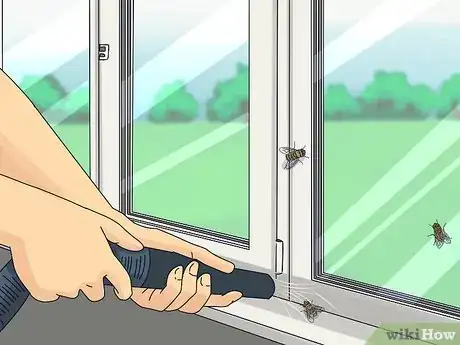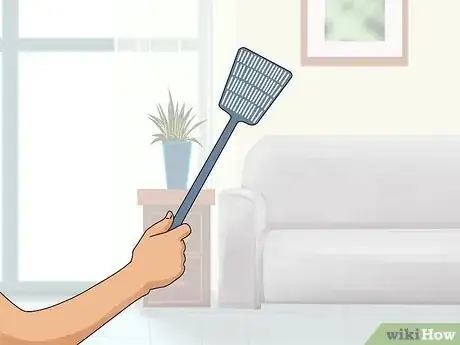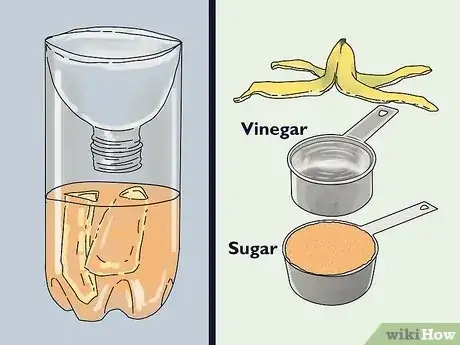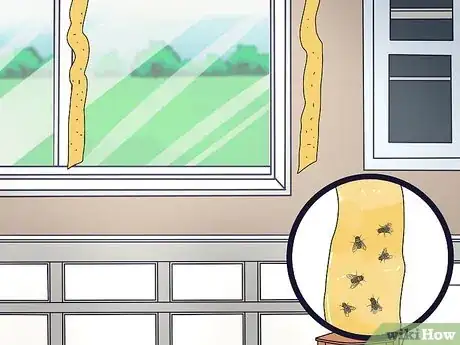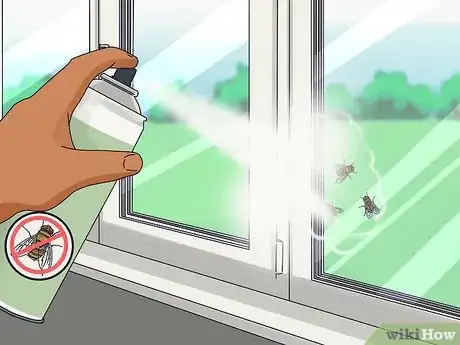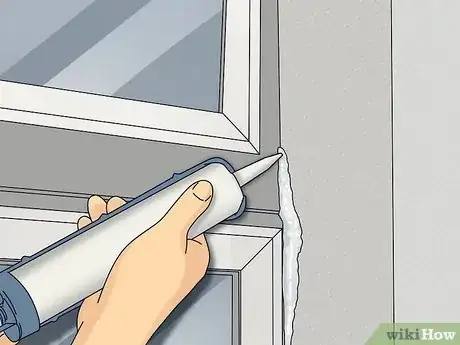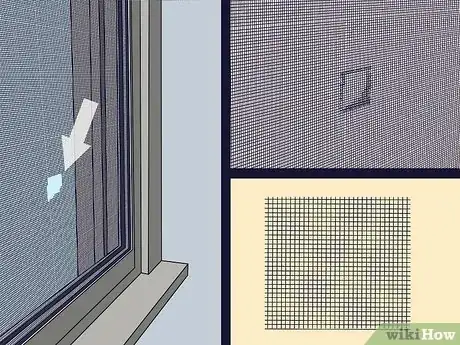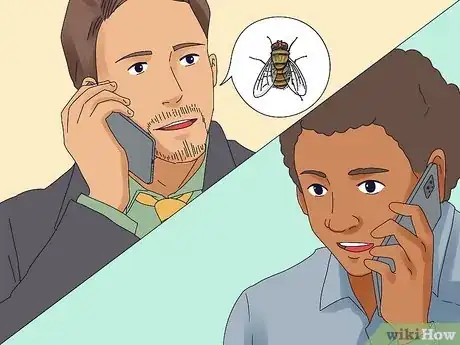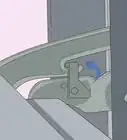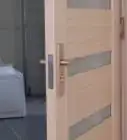This article was co-authored by Joshua Bloom and by wikiHow staff writer, Hunter Rising. Joshua Bloom is a Pest Control Specialist and the Vice President of Operations of Standard Pest Management, a pest control company based in New York City. He has over 20 years of experience in the pest control industry and specializes in commercial and large facility pest control management. Standard Pest Control also specializes in ant, bed bug, cockroach, fly, and rodent control. Joshua is licensed by the NYSDEC (New York State Department of Environmental Conservation) for termite control.
There are 9 references cited in this article, which can be found at the bottom of the page.
This article has been viewed 1,901 times.
Have you ever noticed large black flies somehow getting into your home at the end of summer? While they may look like house flies, you may be dealing with groups of cluster flies that somehow found a way in. Cluster flies get their name because they hibernate in large groups inside walls, and even though they’re harmless, they can still be a nuisance. Lucky for you, it’s pretty easy to get rid of cluster flies on your own! Keep reading for all of the best ways to quickly get rid of cluster flies in your house and prevent them from coming back.
Steps
Recognize cluster flies by golden hairs on their bodies.
-
You’ll usually see large groups of cluster flies together. Cluster flies look like normal house flies, but they’re slightly larger and have wings that overlap over their abdomen. They usually fly a lot slower than standard house flies. If you look closely at the sides of their bodies and see crinkly golden hairs, then you know for sure you’re dealing with cluster flies.[1] X Research source
- Older cluster flies may have rubbed their hairs off.
- You may find clusters of dead flies near windows and lights as well.
- The flies may also give off an odor that’s described as “buckwheat honey.”
Vacuum flies when you see them.
-
The flies move slowly, so they’re easy to suck up. Cluster flies typically fly aimlessly in circles near windows or other lights, so they’ll be easy to find. Once you find a group of cluster flies in your home, pull out the hose attachment for your vacuum and hoover them up. The flies won’t survive getting sucked through the vacuum, so just empty the bag or filter when you’re finished.[2] X Research source
- Vacuuming quickly gets rid of flies you can see, but there may still be more in the walls or outside that haven’t come in yet.
Use a flyswatter.
-
Swat any stray flies when you see them to get rid of them quickly. Attract flies to a bright window by turning off all of the lights in your room.[3] X Research source When the flies start to cluster in the window, quickly hit them with your swatter before they fly away.[4] X Research source
- Make sure you pick up and throw away any dead flies so you don’t attract other pests to your home.
Make a homemade vinegar fly trap.
-
The flies will be attracted to the scent and die in the vinegar. You can use a large empty bottle or a large jar for your trap. Pour 1 cup (240 ml) of vinegar into a container with 1 cup (g) of sugar and a banana peel. Fill the container with water until it’s ⅔ full and set it near where you notice the most flies.[5] X Trustworthy Source U.S. Department of Housing and Urban Development U.S. government agency devoted to helping Americans meet their housing needs and supporting community development Go to source
- Change the water and bait once the surface of the solution is covered with flies.
Hang flypaper strips around your home.
-
Cluster flies easily get caught on the sticky strips and can’t get off. Hang the strips near windows, doors, and lights for the best cluster fly control in your home. Once the flypaper strips fill up, throw them away and replace them with fresh ones.[6] X Research source
- You can buy flypaper strips from your local hardware store or online.
Spray the flies with aerosol pesticides.
-
Pesticides with pyrethroids kill cluster flies on contact. Choose a spray meant to control flying insects inside that contain pyrethroids or pyrethrin. Close any windows and doors in the room so the pesticides are the most effective. Point the aerosol in the air near the flies and spray the mist. The flies will quickly die so you can sweep them up and get rid of them.[7] X Research source
- Indoor aerosol pesticides don’t have a residual effect, so they won’t prevent new flies from coming into your home.
- Always read the safety label on pesticides you use and follow the instructions carefully.
Apply pesticide dust behind your walls.
-
The dust reaches hidden nests of cluster flies that haven’t come out yet. You can usually find a cluster fly nest in south- or west-facing walls since they get the most sun. Choose a desiccant dust pesticide that dries out the flies when they come into contact with it. If you see a gap, hole, or opening where flies have come into your home, place the duster nozzle inside and pump a few puffs into the wall.[8] X Research source
- You can buy desiccant dust from your local hardware store.
Seal gaps and cracks around your home.
-
Flies won’t be able to get inside if you block their entrances. Cluster flies get into your home through any small entrance, so check inside and outside for any holes, gaps, or cracks that are possible entrances. Use caulk to fill in small gaps and cracks and apply weatherstripping around doors and windows to keep the flies from coming in.[9] X Research source
- If you need to get rid of cluster flies in your basement, be sure to check around any cellar windows and corners.
Fix screens on your windows.
-
Mesh screens let you keep your windows open while keeping out flies. Check all of the screens on your windows and exterior doors to see if they have any damage. If your screen has holes, cover them with patches to stop flies from squeezing in. Choose a screen mesh that has 14–16 strands per inch to keep cluster flies out of your home.[10] X Research source
- You can buy a screen patch online or from your local hardware store.
Prevent flies from getting in with exterior pesticides.
-
Spraying residual pesticides can keep flies out next summer. Use a pesticide that has a synthetic pyrethroid or dinotefuran meant for exterior use. Use a sprayer or have a professional come in the autumn to apply the pesticides around the exterior of your home. Since the pesticides are residual, they’ll kill flies that try to get into your home to hibernate.[11] X Trustworthy Source Penn State Extension Educational organization dedicated to delivering science-based information to people, businesses, and communities Go to source
- You can get exterior pesticides from your local yard care store or online.
Call a professional for large cluster fly infestations.
-
An exterminator has stronger chemicals to control cluster flies better. If you want to completely eradicate the cluster flies in your home, an exterminator will know how to do the job quickly. Contact a few different companies about the cluster fly infestation to find the best deal for treating your home.[12] X Research source
You Might Also Like
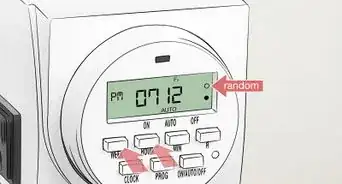 How to Set an Indoor or Outdoor Outlet Timer
How to Set an Indoor or Outdoor Outlet Timer
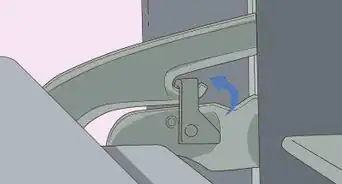




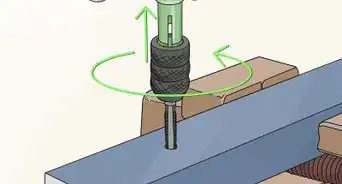


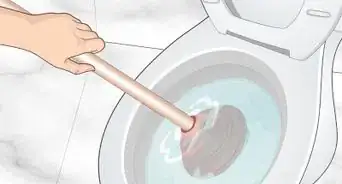


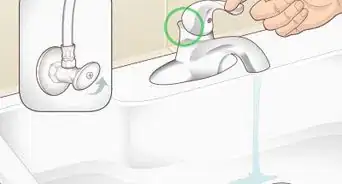
References
- ↑ https://portal.ct.gov/-/media/CAES/DOCUMENTS/Publications/Fact_Sheets/Entomology/Cluster_Fly_Pollenia.pdf
- ↑ https://extension.umaine.edu/ipm/ipddl/publications/5010e/
- ↑ https://extension.umn.edu/nuisance-insects/flies#controlling-fall-nuisance-flies-108561
- ↑ https://extension.missouri.edu/publications/g7388
- ↑ https://www.hud.gov/sites/documents/HUDGB7C7GUID.PDF
- ↑ https://extension.umaine.edu/ipm/ipddl/publications/5010e/
- ↑ https://extension.entm.purdue.edu/publications/E-7/E-7.html
- ↑ https://extension.colostate.edu/topic-areas/insects/flies-in-the-home-5-502/
- ↑ https://portal.ct.gov/-/media/CAES/DOCUMENTS/Publications/Fact_Sheets/Entomology/Cluster_Fly_Pollenia.pdf
About This Article


